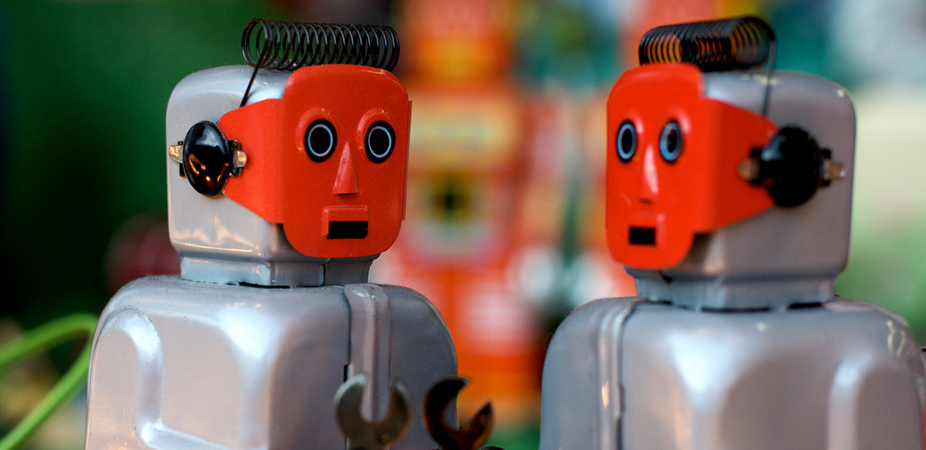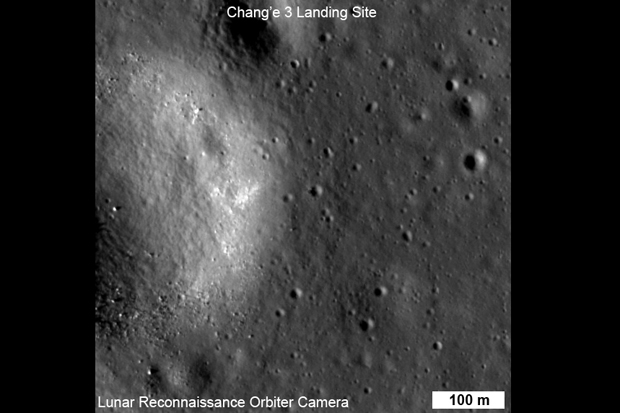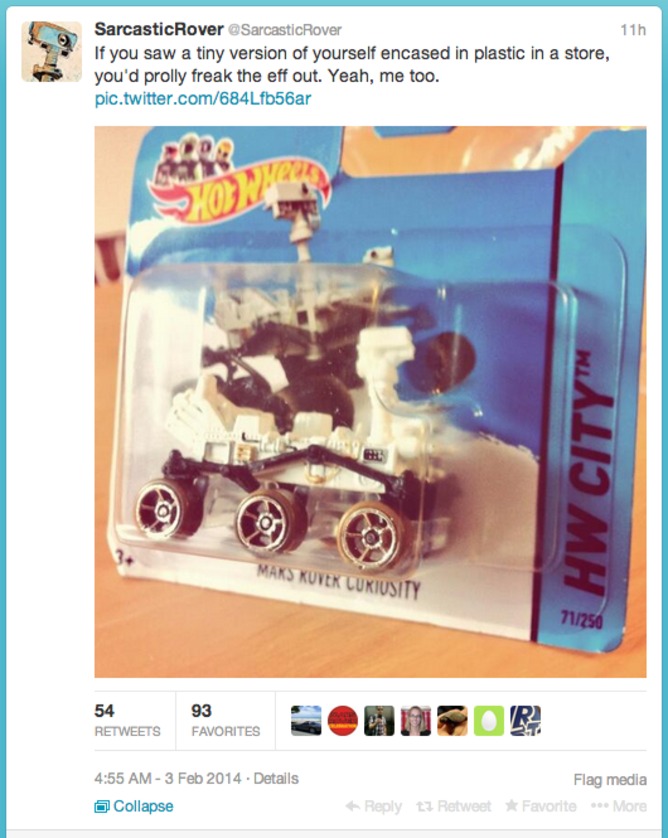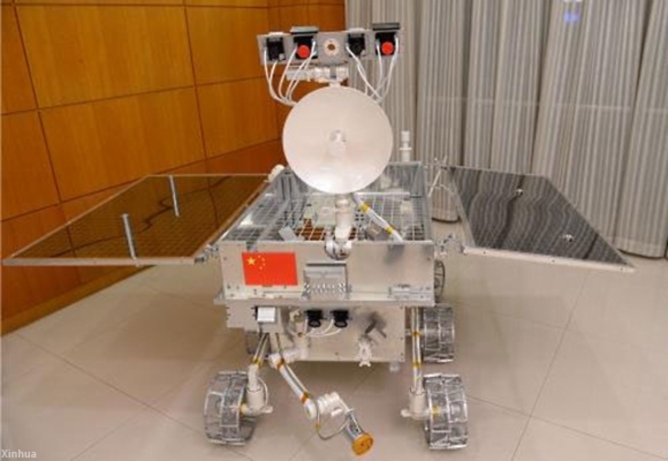
Dead or Alive, China's Yutu Rover Says Much About How We Relate to Robots (Op-Ed)

This article was originally published at The Conversation. The publication contributed the article to LiveScience's Expert Voices: Op-Ed & Insights.
This weekend, the moon’s fortnightly rotation cycle turns China’s lunar rover Yutu (the Jade Rabbit) and its solar panels toward the sun once again … but whether the rover wakes up or not remains to be seen, as Yutu already announced its impending death to Earth-based watchers with a series of first-person messages on January 25.
The messages were posted on China’s equivalent of Twitter, Sina Weibo, from an unofficial account believed to be run by a group of enthusiasts.
The rover has been on the lunar surface since December 15, when it was deployed from the Chang’e 3 lander.

Since then, it has covered 100 metres with its six-wheel locomotion.
As space scientists struggled to get Yutu to respond to commands to fold in its solar panels and external equipment, the two-week lunar night descended, plunging the exposed equipment into -150C temperatures without protection.
In 1971, Russia’s Lunokhod 1 similarly failed to make it through to the next dawn, even though it had successfully entered mechanical hibernation.
Get the Space.com Newsletter
Breaking space news, the latest updates on rocket launches, skywatching events and more!
It’s not impossible that Yutu will survive the night. But it certainly doesn’t look good.
What is different about its probable death, though, is the way that it has been conveyed to the public via the Chinese state news agency Xinhua:
I’ll tell everyone a little secret. I’m actually not that sad. I’m just in my own adventure story, and like any protagonist, I encountered a bit of a problem. Goodnight Earth. Goodnight humans.
More than 6,000 people have responded to the posts with messages of hope and appreciation. (Some, though, thought it “creepy”.)
For them, it doesn’t matter that Yutu is not actually sentient, nor directly responsible for the messages.
Space fandom
Yutu is not the only spacecraft to have a public fan base. Social media such as Twitter and its equivalents play a prominent role in this. Other high profile spacecraft which communicate in first person include @MarsCuriosity and @NSFVoyager2.
But is this a trivialisation of serious scientific endeavours? It could be argued that these engagements are cynical attempts to gain public support for funding space exploration; perhaps a means of glossing over the vast amounts of money spent on space while (in the view of critics, more urgent) terrestrial problems remain underfunded.
However, many of these accounts are not official, but run by fans. This is the case for Yutu’s microblog, as well as @NSFVoyager2 and the popular @SarcasticRover. Unconstrained by communications policies, these accounts sometimes use humour to great effect.

The question, then, is whether this approach makes for effective science communication. Does following an anthropomorphised spacecraft lead people to engage with the science behind it?
Vanessa Hill, CSIRO’s Social Media Manager, argued in an article last year that:
By personifying the spacecraft in the form of social media accounts we’re characterising spacecraft in an easily accessible way which allows people to connect with specific missions.
Human-robotic interactions
The issue, however, is much broader than it at first appears. We can take this a step further into the field of social robotics.
While the development of the fully humanoid robot has been a longstanding scientific ambition, any human-like feature can be co-opted into building a relationship with machines. We can see this in the natural tendency to see faces in inanimate things.
On rovers like Yutu, cameras and antennas often look a little like necks with a head emerging from the body. It’s enough for us to attribute emotional states to them.

In this engagement, whether or not the robot is capable of feeling these emotional states is irrelevant. It’s more whether the robot appears to have them. This is what is commonly known as the Turing Test.
Of course, humans reading emotions into a space robot and conveying them as if they originated from the robot is very different. But perhaps the time when such robots will be designed to translate their mechanical states into statements that they tweet directly is not too far off.
In all of this, though, we are still thinking of “us” and “them”. Even if it’s not actually the case, we like to treat the robot as a separate being with sentience. It makes the communication exciting.
We can even take this a step further. These first-person communications as if from spacecraft bridge the distance between remote and proximate interaction.

In remote interaction, humans and robots are separated in space, and even sometimes in time, such as the time lag in communication between Mars and Earth.
In proximate interaction, humans and robots are co-located, for example, in the same room or facility. The physical distance affects how people behave around machines, as well as the robot’s level of autonomy.
What these social media interactions do is make people feel more present in the remote location, collapsing the distinction between near and far. It doesn’t end there, though.
A post-human perspective
If we take a “post-human” perspective, we can look at space robots as extensions of ourselves. We don’t have to anthropomorphise spacecraft: they can actually be our senses. This is how metatechnology researcher Robert Pepperell explained it in a 2004 conference paper:
This state of co-extension requires that we revise our attitude towards human-machine interaction: if technology is now regarded as an extension of human cognition, then the classical model of interaction whereby two distinct entities are interfaced, one sentient and one insentient, is inaccurate. In its place we must posit an exchange of cognitive activity between the sentient user and the cognition embodied in the device.
Yutu’s live microblogging of its own death from the first-person perspective could be seen, on the one hand, as a measure of the extent to which social media have become pervasive in engaging the public with civil space exploration.
But I think it’s something more. Space robots are not yet fully autonomous, as they rely on human commands. As Yutu shows, however, the exchange is not all one way. Even if the machine itself is not generating the posts, there is still an interaction whereby the actions and “experiences” of the rover are translated into a verbal message which elicits human emotional responses.
The public may not be influencing Yutu’s behaviour, but it sure as heck is affecting ours. These kinds of interactions are charting future territory in social robotics. Yutu’s legacy is part of this new cognitive exchange.
Alice Gorman does not work for, consult to, own shares in or receive funding from any company or organisation that would benefit from this article, and has no relevant affiliations.
This article was originally published at The Conversation. Read the original article. The views expressed are those of the author and do not necessarily reflect the views of the publisher. This version of the article was originally published on Live Science.
Join our Space Forums to keep talking space on the latest missions, night sky and more! And if you have a news tip, correction or comment, let us know at: community@space.com.

Dr. Alice Gorman is an internationally recognized leader in the field of space archaeology. She is an Associate Professor in the College of Humanities, Arts and Social Sciences at Flinders University, where she teaches the Archaeology of Modern Society.
Her research focuses on the archaeology and heritage of space exploration, including space junk, planetary landing sites, off-earth mining, rocket launch pads and antennas.
She is a member of the American Institute of Aeronautics and Astronautics, the Advisory Council of the Space Industry Association of Australia and the Australian Institute of Aboriginal and Torres Strait Islander Studies.
Her book "Dr. Space Junk vs the Universe: Archaeology and the Future" (2019) won the Mark and Evette Moran NIB People's Choice Award for Non-Fiction and the John Mulvaney Book Prize, awarded by the Australian Archaeological Association. It was also shortlisted for the Queensland Premier's Literary Awards, the NSW Premier's Literary Awards, and the Adelaide Festival Literary Awards.
Alice tweets as @drspacejunk and blogs at Space Age Archaeology.









